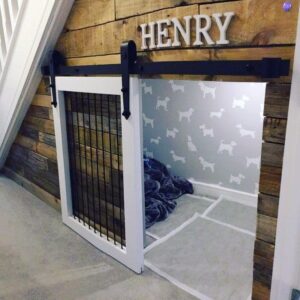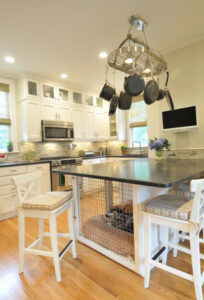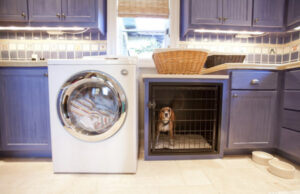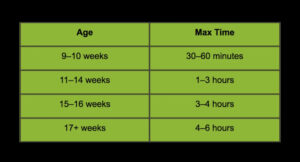Crate Training your puppy or adult dog
Wondering about the best way to crate train your puppy or adult dog? Or if you should even bother? Perhaps you’re worried that it might be cruel to confine your dog to a crate? (It’s not, when done right!). Or maybe you’re unsure of all the benefits of crate training? (There are lots!)
If you’re at all curious about crate training a dog, regardless of their age, you’ve come to the right place. This fact sheet should help answer all your questions (including how long you can leave a puppy in a crate!) and walk you through a stress-free process of crate training.
First, let’s start with clearing up some potential confusion and putting your mind at ease. You may have seen conflicting articles or received differing opinions on whether dogs are “den animals” (animals that live the majority of their lives underground or in a cave).
The truth is that while dogs aren’t technically “den animals,” as they certainly don’t spend the majority of their lives in a den, they do have a “denning instinct.” Pregnant dogs seek out the safety of a den to birth and rear their pups. So some of your puppy’s earliest memories tie back to the comfort and safety of being with mom (and litter mates) in a safe, secure, den-like space.
Additionally, when dogs are ill, injured, or otherwise needing a place to relax and feel safe, they will seek out a den or “den-like” protected space.
While you may worry that your dog will see their crate as a “jail cell,” the truth is actually quite the opposite. When crate training and conditioning is handled correctly, a crate provides a calming and protective space where your dog can relax and feel secure – and truly be safe.
Benefits of Crate Training Your New Puppy or Dog
Crates benefit both ends of the lead: your dog and you. They aren’t just relaxing and protective for your pup, they also provide you with peace of mind and precious moments of relaxation!
Here are some of the reasons why crate training is beneficial:
- Help with house training: A crate is a great tool to help house train a puppy.
- Noise refuge: The crate provides a safe space for your dog to relax, as well as a place to retreat during anxiety-inducing times like holidays, parties, thunderstorms, rampaging kids, and a host of other potentially stressful events that happen in our homes on a regular basis.
- Easy transport: Crates make it easier to safely transport your dog in the car.
- Injury and toxicity prevention: A crate can help prevent injuries and poisonings for dogs when they’re left home alone while you run errands or go to work. (After all, you can’t — and shouldn’t — always bring them along with you. Avoiding Heat Stroke on a warm day is just one reason why.)
- Protect your stuff: Crate training helps protect your furniture, floors, and the rest of your home while you’re out;
- Home away from home: A dog that’s properly crate conditioned will be more comfortable and relaxed when they need to be crated at the vet, groomer, or a boarding kennel.
- Post-surgery convalescence: They’ll also be happier, safer, and less likely to have surgical failure or other complications following any surgeries that require post-operative exercise restriction (e.g., spay, fracture repair, cruciate surgery).
How to Choose a Crate
- Start by selecting a crate that’s big enough for your dog to comfortably stand up, turn around, and lie down in with outstretched legs. Bigger is not better! Go too big and your dog may not have as much hesitation to go pee or poo in there. Its important to measure your dog before you go shopping so you can purchase the right size of crate.
- For puppies, continue to follow the size guide of just big enough to stand, turn, and lie down in. Of course, this could get expensive, as you may have to get another, larger crate as your pup grows. Fortunately, there are crates that have removable and adjustable partitions, allowing the crate to “grow” with your puppy. Save yourself a chunk of change and opt for one of those!
- Choose the crate’s materials. “Airplane kennels” (a plastic crate with a metal door) or metal wire-type crates are typically the best — especially for a puppy or adult dog just starting their crate training. These materials are typically sturdier and easier to clean than the cloth-type crates. Once your dog already loves being in a crate, if you want to get a cloth crate for easier transport or a fancy wooden one to better match your home décor, have at it. But it’s a good idea to start and progress though crate training with an airplane-type or metal wire crate.
Where You Should Put Your Dog’s Crate:
- Choose a quiet spot away from high-traffic areas.
- Don’t place the crate in direct sunlight, right next to a radiator, or on top of an in-floor heating or cooling vent.
- Be sure there are no power cables, electrical cords, or poisonous houseplants, like Sago Palms, that your curious (or potentially bored) puppy might be able to reach when crated.
- Should you put your pup’s crate in your bedroom? That’s your call. Before you make that call though, consider how sound (or not) of a sleeper you are, whether there are other pets in the home, what other crate locations are available to you, and any other personal factors – such as who will look after your dog if you are ever away from home and would they allow your pet to sleep in their bedroom etc!
- Check out these cool, custom dog crate ideas! Here’s an ‘under the staircase’ one a’la Harry Potter (but nicer looking)! And another option is ‘underneath the kitchen counter’ built-in dog crate. Before committing to this in your room, just be sure that your dog isn’t stressed by the sound or vibration of the washer or dryer and don’t put it right next to the dryer, as that could get quite warm for pup!



Your Dog Should “Go Naked” in Their Crate!
All puppies and adult dogs – and especially those who are still getting used to their crate – should have their harnesses and/or collars removed before being left alone in their crate. Harnesses, collars, and dangling ID tags can easily get caught on crate doors and between the bars of the crate, causing a huge and otherwise avoidable strangulation risk.
What Goes in Your Dog’s Crate?
You’ll want to make sure your pup finds their crate comfortable, so including bedding and appropriate toys is essential. Lots of factors determine what other items work best for your dog in their crate, such as their age, activity level, and how “chew-happy” or destructive they are; head over to this article about what to put (and not put) in your dog’s crate for more information and recommendations.
How to Crate Train Your Dog
Here’s a step-by-step guide to crate train a puppy or adult dog. It’s provided by Preventive Vet’s contributor, Casey Newton, BS, CPDT-KA, trainer extraordinaire and owner of Wonder Puppy. Translation: She really knows what she’s talking about when it comes to crate training puppies!
Here are her steps for stress-less crate training:
Step 1: Get It All Out
Any time you are putting your dog in their crate – be it for a crate training session or when putting them in there before leaving the house – make sure they’ve had a good opportunity to go out to potty and to get in some good play and exercise, too.
Step 2: Develop a Positive Association With the Crate
- Place cozy blankets and favorite toys inside the crate with the door wide open and allow your puppy to explore it on their own. If they don’t enter the crate, toss in a few treats to encourage further exploration.
- Any time you catch them going in, immediately click with a clicker or use your marker word) to let them know that’s the behavior you want. Then give them a treat and praise. (Not sure how to clicker train? Check out her “Introduction to Clicker Training” article.)
- Feed your puppy their meals in the crate. If your puppy is still nervous about entering the crate, place the bowl closer to the opening for the first feeding and gradually move it farther into the crate.
- As your pup becomes comfortable eating inside the crate, you can close the door to the crate during feeding. Be sure to open the door as soon as your pup is finished.
Step 3: Work on Duration
While it may not happen the first time, the goal is to be able to leave your puppy in a closed crate for 15 minutes without stress.
Place your puppy in the crate (or ask your puppy to enter the crate) with their favorite toy or a food puzzle they love and close the door for about 15 seconds. Then let your puppy out of the crate and make a “5-second trade” for treats (give your puppy treats for 5 seconds) while you place their toy or food puzzle out of their reach. Hang out near the crate for about 10 seconds and repeat. Build up to longer durations until they are comfortable being closed in the crate for 15 minutes. Here are some additional tips to keep in mind:
- Progress slowly and do not leave your dog’s side.
- You’ll know you’re doing it right if your dog stays happily engaged with their toy or food puzzle, rather than whimpering or acting anxious.
- If your puppy struggles to meet the goals, try increasing the value of their toy or food puzzle (fill it with their favorite treats!) and/or make the time shorter.
- Throw in easy durations between the longer durations (i.e., 30 seconds, 45 seconds, 20 seconds, one minute, etc.).
- To make the first step easier and less scary for your puppy, close the crate door most of the way, but keep your hand inside. Hold onto their toy or food puzzle while they play with it, and praise and talk to them in a comforting voice. Do this until your puppy is comfortable playing even when your hand is out of the crate.
Step 4: Increase Your Distance From the Crate
Repeat Step 3, except increase distance instead of duration. Close the crate door with your puppy inside, walk halfway across the room, return, open the crate and make a trade. Repeat this until you are able to walk out of sight and return without your puppy feeling stressed.
Step 5: Distance + Duration
Add duration to the distance. Start with increments of 15–30 seconds while you walk around the house in and out of sight, until you reach 5 minutes. Then increase to 5–10 minute increments at a time. Your puppy should be enjoying their toy or food puzzle and seem comfortable. If not, make the step easier by leaving for a shorter amount of time, before extending the duration to make it more challenging again.
How Long Can I Leave My Puppy in Their Crate?

Use this chart as an age-based guide for how long your pup can “hold it” and stay in their crate. Note that these are consecutive minutes/hours, not total time during the day or night.
If you are unable to give your puppy a break from their crate within the times listed above, set up a puppy zone or long-term confinement area instead of a crate.
Step 6 and Beyond: Distraction and Real Life
Once your puppy is comfortable being left in the crate for 15 minutes with their toy or food puzzle, you can start adding additional elements to the training:
- Leave your puppy in the crate for longer amounts of time.
- Try it without the toy; or, if using a food puzzle, delay your return once they’ve eaten all the stuff inside. Note: You should always give your dog a safe toy or entertaining food puzzle when crating them, but you also want them to be okay when the entertainment that a toy or food puzzle provides runs out. If your puppy has been exercised and did well with the first five steps, this should be a natural and easy progression.
- Apply crating to all of the necessary real-life scenarios, such as when you sleep, eat dinner, have visiting guests, ride in the car, etc. If your puppy vocalizes a little because they are excited or want to be let out, wait until they are calm before letting them out.
That said, when first starting out with crate training (especially when working on Step 2, developing positive associations with the crate) you don’t want to let your pup “cry it out.” If they’re really not having fun, just let them out and start over at the duration/distance at which they were last comfortable and then work up more slowly.
Crate Training Do’s and Don’ts
Don’ts:
- Don’t use the crate for punishment or reprimand your dog while they’re in their crate. Otherwise your dog will come to associate their crate with stress and other negative experiences, making crate training efforts much harder for you both.
- Don’t leave your dog in the crate all day. Crates are no substitute for a dog babysitter and a dog that is locked in a crate all day and night may develop anxiety and depression. If your work or other schedule conflicts will keep you away from home for a long chunk of the day, consider hiring a pet sitter or walker like SuPaw Nanny or taking your dog to daycare here so they can get the physical and mental exercise they need each day.
- Don’t leave young puppies in the crate for more than 3–4 hours at a time – they need more frequent potty breaks. See the table, “How Long Can I Leave My Puppy in Their Crate?” for a guide on how long a young pup can typically “hold it” and be left alone in their crate.
- Don’t make a big production out of your departure from the home. Have your dog “kennel up” and start working on their food puzzle or toy several minutes before your departure. Then just leave the house without fanfare while they’re happily playing with their toy/food puzzle.
Do’s:
- Do work in short training sessions and take the pace of advancement at your pup’s pace — don’t try to rush things.
- Do use LOTS of treats, patience, and praise.
- Do consider calming pheromones (like an Adaptil Diffuser) and relaxing music, which can help with crate training and can continue to be helpful even once your dog has mastered being in their crate.
- Do make sure that your pup has had some fun playtime and an outdoor potty opportunity before each crate training session.
- Do keep the excitement to a minimum when you return home, both during training and when you start leaving your pup crated during the day for real. Your low-key arrival will help reduce your dog’s anxiety and anticipation of your return home.
- Do take your puppy outside for a potty break as soon as they are let out of the crate. This will help to teach them that “potty time” happens right after “crate time,” which will help solidify your pup’s potty training.
You’ll Need Lots of Treats for Crate Training
Crate training the right way means using a LOT of rewards! For most puppies and dogs, the best rewards are food rewards (“treats”). Of course, every dog is different, but many are food motivated. Every food reward carries a different “value” for a dog. For example, many dogs consider a small piece of cheese, boiled chicken, or liverwurst to be a “high-value reward,” meaning they’ll do just about anything for it!
Fortunately, most dogs will happily progress through their crate (and other) training with any one of the host of yummy training treats. There are some low-cal treat choices featured below. Some dogs like their kibble as a treat, too. You can give a portion of their daily meals as training rewards throughout the day, which will help you avoid giving too many calories in treat form, yet still reward their (p)awesome training progress!
Once you’ve progressed to the point where you’re trying to get your dog to spend progressively longer periods of time in their crate, you’ll want to start replacing (or supplementing) their training treats with longer-lasting treats and food puzzles.
Food puzzles are great because they occupy your dog’s mouth and brain for a much longer period of time than a simple treat or regular chew toy. Good examples include the variety of “stuffable” Kong toys, and puzzles.
When shopping for interactive toys, there are a few things to take into consideration.
- Large dogs and strong chewers will need a size-appropriate toy that they can’t swallow, and perhaps something more durable if they are strong chewers.
- Small and flat-faced dogs also need a size appropriate toy that is small enough that they are able to play with it. They may also need softer toys since their jaws are not as strong.
Dogs Crate Train at Different Paces
As with any type of training, all dogs will learn and progress through their crate training at a different pace. The keys to success are consistency and patience (and lots of treats and positive reinforcement!).
Remember, your puppy is unique and their potty training success depends on you. While some puppies might take longer to grasp the concept of only going to the bathroom outside, the more committed you are to the six steps outlined above, the faster you’ll see results and the sooner you will have a dog that LOVES their crate … and you’ll have a safer home and less stress in your life, as well.
Good Luck!
As always, we hope this information has been useful!
Regards,
SuPaw Nanny

